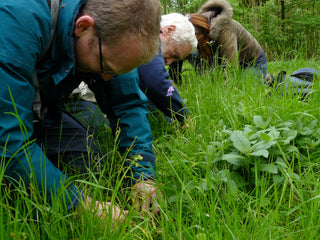Phytochemicals, a word that can create an immediate barrier with how complex it sounds but its meaning is quite simple, plant chemicals.
What they are and what they do to the human body?
The British countryside is full of familiar faces even to those new to foraging for food or medicine: nettles in hedgerows, elderflower perfuming early summer lanes, and dandelions punctuating lawns. Beyond their place in folklore and cuisine, many UK native plants are rich in phytochemicals - compounds plants produce for defence, signalling and survival. These molecules interact with human biology in useful and sometimes unpredictable ways. Below is a guide to the main types of phytochemicals you'll find in UK plants and examples of local plants that contain them, and how they can affect the body.
What are phytochemicals?
Literally "plant chemicals" are non-nutrient compounds produced by plants. They include large families such as flavonoids, polyphenols, tannins, terpenes, alkaloids, glucosinolates, carotenoids, saponins and glycosides. Many act as antioxidants, anti-inflammatories, antimicrobials or as modulators of enzymes and cell signalling. In humans these actions can translate into short-term effects (e.g., diuresis, astringency, stomach-settling) and longer-term modulation of processes like inflammation, blood pressure regulation or gut microbiota balance. Plant chemicals directly interact with the cells of humans and it is these interactions that make them so useful... or deadly.
Common classes and how they act
Flavonoids and polyphenols - Found in red berried plants and coloured fruits, elder and hawthorn. They often act as antioxidants, scavenging free radicals, and modulate inflammation and vascular function by affecting enzyme activity and cell-signalling pathways. Flavonoids in Chamomile is what causes the relaxing effect many get from this plant. Dark chocolate is rich in flavonoids.
Tannins - found in many plants, oak bark and some leaves. Tannins bind proteins and have astringent and antimicrobial effects (think "tightening" of tissues), useful topically for minor skin irritation but potentially irritating to the gut in large amounts. The rose family is particularly high in tannin content as is black tea. Be careful if drinking large amounts of black tea as the tannins can tan your intestines and limit your ability to absorb nutrients such as iron.
Terpenes and essential oils - common in fragrant flowers and leaves; they can have antimicrobial, anti-inflammatory or mild stimulant effects (e.g., in some woodland herbs). If a plant is really aromatic then think terpenes, examples are lavender or peppermint. Terpenes are massively anti-microbial and can both be sedentary and stimulating
Glucosinolates - found in cruciferous plants like watercress and some wild mustards. When broken down they produce isothiocyanates, compounds that influence liver detox enzymes and possess antimicrobial properties.
Alkaloids and glycosides - often pharmacologically potent. Some - like the cardiac glycosides in foxglove - have strong effects on the heart and can be toxic. Others may be used medicinally in controlled amounts. Liquorice is high in glycosides and alters your hormone levels and effects your blood pressure. Caffeine is an alkaloid.
Carotenoids and anthocyanins - pigments in berries and leaves that act as antioxidants and contribute to eye and skin health. You must have the heard the saying about eating carrots helping you see in the dark? Well carrots are high in carotenoids and are good for your eye health.
Saponins and bitters - influence digestion, can modestly lower cholesterol, and stimulate bile flow or appetite. Daisies contain saponins and stimulate an expectorant action on your lungs if consumed, equally when applied topically the saponins disrupt the pooling of blood helping to clear up bruises. Dandelions bitter action stimulates digestion.
Why should you learn this?
It has become my opinion through further study of plants that although knowing a plant and its use is good, being able to identify plant chemicals and their actions is better. It is my mission to help people shift their thinking to looking for a plant action from its chemicals than look for a specific plant. If someone has a cut they may think “I need yarrow to stop the bleeding”, what I want them to think is I want the action of drying and tightening to stop the bleeding and something with anti-microbial properties to clean the injury. By shifting the thought in this way, you have opened up the field from searching for one plant to now looking for an action that may be found in around 5 plants around you therefore improving your chances of finding a plant to help you.

